
You can always tell you’ve gone too far when you reach the wind farms. They populate the barren wastes of California’s northern interior, rows of them spinning atop camel-haired hills starved of moisture to slake the thirst of the Los Angeles glitterati. These motionless pinwheels are an ironic green afterthought to the ecological disaster that embraces the Interstate-5 freeway: now that we’ve created the dust bowl we may as well use the wind to power our air filters. There’s more than wind and dust out here. This is where they put the kinds of facilities the government doesn’t want people snooping around in. Lawrence Livermore National Laboratory is one of them—a secretive development center for our nation’s nuclear arsenal during the Cold War. Here in Livermore, the world’s finest physicists are on the verge of a breakthrough that could power entire cities on a bathtub full of water. The National Ignition Facility, also known as the world’s largest laser, is on the cusp of achieving the first break-even nuclear fusion reaction. NIF is the U.S. Department of Energy’s Sagrada Familia. If successful, the four billion dollar facility will be the first ever to demonstrate Ignition: a fusion reaction that releases more energy than was put into it. The energy, national security, economic and environmental ramifications for the United States, if not the world, would be staggering. ScriptPhD.com’s Stephen Compson gained ultra-exclusive access to the normally reclusive facility, including tours, interviews, and a peek at the lasers that could hold the key to the United States’s global rebirth. With nuclear fusion on the brink of break-even, Stephen recounts we tour the world’s next scientific revolution.
The Photon Valley
Livermore is not so much a city as it is a byproduct of the lab at its center. This small suburban community lies halfway between San Francisco’s Bay Area and the Interstate 5 that allows truckers a north-south passage between the “Two Californias.” They call it The Photon Valley, the world capital of laser technology and all things light-related. Moth-like high-tech subcontractors orbit the facility’s perimeter. Charon Sue Wollard is Livermore’s second Poet Laureate. Her poem Steller Gest hints at the secrets locked away in the cathedral of optics:
amid the shadows of the Earth
while a future barely glimpsed
is in a chamber being birthed”
I check into a room that smells like a Pine-Sol explosion and cruise the two main drags looking for a meal. A pretty girl takes my order at a pizza place, and I realize for the first time what a physics town this truly is. Her eye shadow has been cross-sectioned into bandwidths, showing five different colors on each eyelid. It is a cosmetic display of the visible light spectrum. She smiles and asks if I’d like a beer.
Fusion is the process by which two atomic bodies, driven together by an overwhelming force, merge to become one heavier nucleus. It is the reverse of fission, the splitting process that gave us the atomic bomb and the conventional nuclear reactor. An atomic act of coupling, fusion powers our sun and every other light in the night sky. At the National Ignition Facility here in Livermore, scientists and engineers stand at the threshold of tapping into that process to create a limitless supply of clean energy. When the stars burn out, we’ll make our own.

The Birth of a Star
The car is completely covered in bird crap. This isn’t just one or two droppings caked onto a dirty hood, but a carpet-bombing by a flock of irritably-boweled miscreants. Lynda, the public affairs officer assigned to chaperoning me through the facility, smiles apologetically and gestures toward the culprits in the dense trees that loom over the parking lot.
Like a quiet family home in mid-Los Angeles, the Livermore Lab hides from prying eyes with a protective wall of foliage that makes it look more like a nature preserve than a nuclear weapons facility. But behind the trees they have plenty of barbed wire and guards armed with assault rifles. I finger the clearance pass with my photo on it and thank her for the souvenir. She looks puzzled, “You won’t be allowed to keep it.” Bruno Von Wonterghem is exactly the sort of Germanic super-scientist you’d imagine running operations at the world’s largest laser facility. His accent lends an easy everyday quality to words like laser, optics, and Neodymium. He has the propensity to trail off into a mumble that could fill an entire page, like he’s been talking about the laser’s attributes merely for his own benefit. Bruno has been working on laser systems at the lab for almost two decades. Every time I ask a question this strange light comes into his eyes, as though he’s realizing for the first time that there are people in this world who don’t know about the National Ignition Facility.

From the outside, the building doesn’t quite look real. It’s glossy, like one of those photos a developer might put up in front of a vacant lot to convince people that something could be built there. I’ve been trying to get into this facility for over a year, and to my disappointment it looks exactly like the pictures. Most of the facility’s iconic equipment is on display in the front lobby, and the walls throughout are lined with posters explaining how everything works. The whole thing screams field trip, and I’m starting to wonder if there is actually any science that takes place here. Then they show me the laser bays.
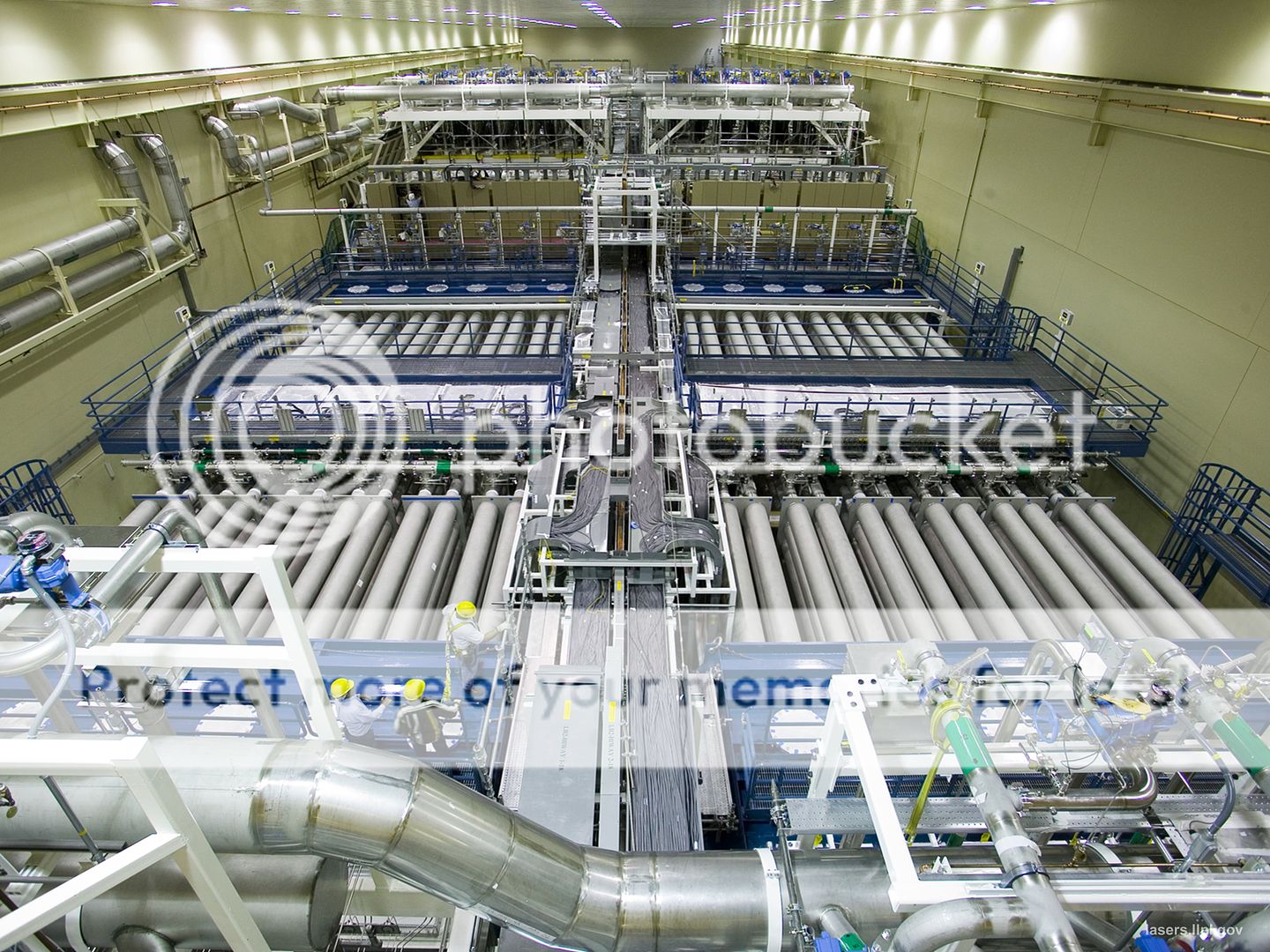
Every article you will ever read about the National Ignition Facility measures the size of its laser bays in terms of football fields (four). It’s difficult to get a feel for the scale from the picture, because this is only one of two laser bays and what you don’t realize looking down on it is that the whole system is suspended a story above the ground, putting us three stories up. They do that because any replacement modules have to be loaded from underneath in pre-assembled clean rooms so that any outside particles will fall out of the system.
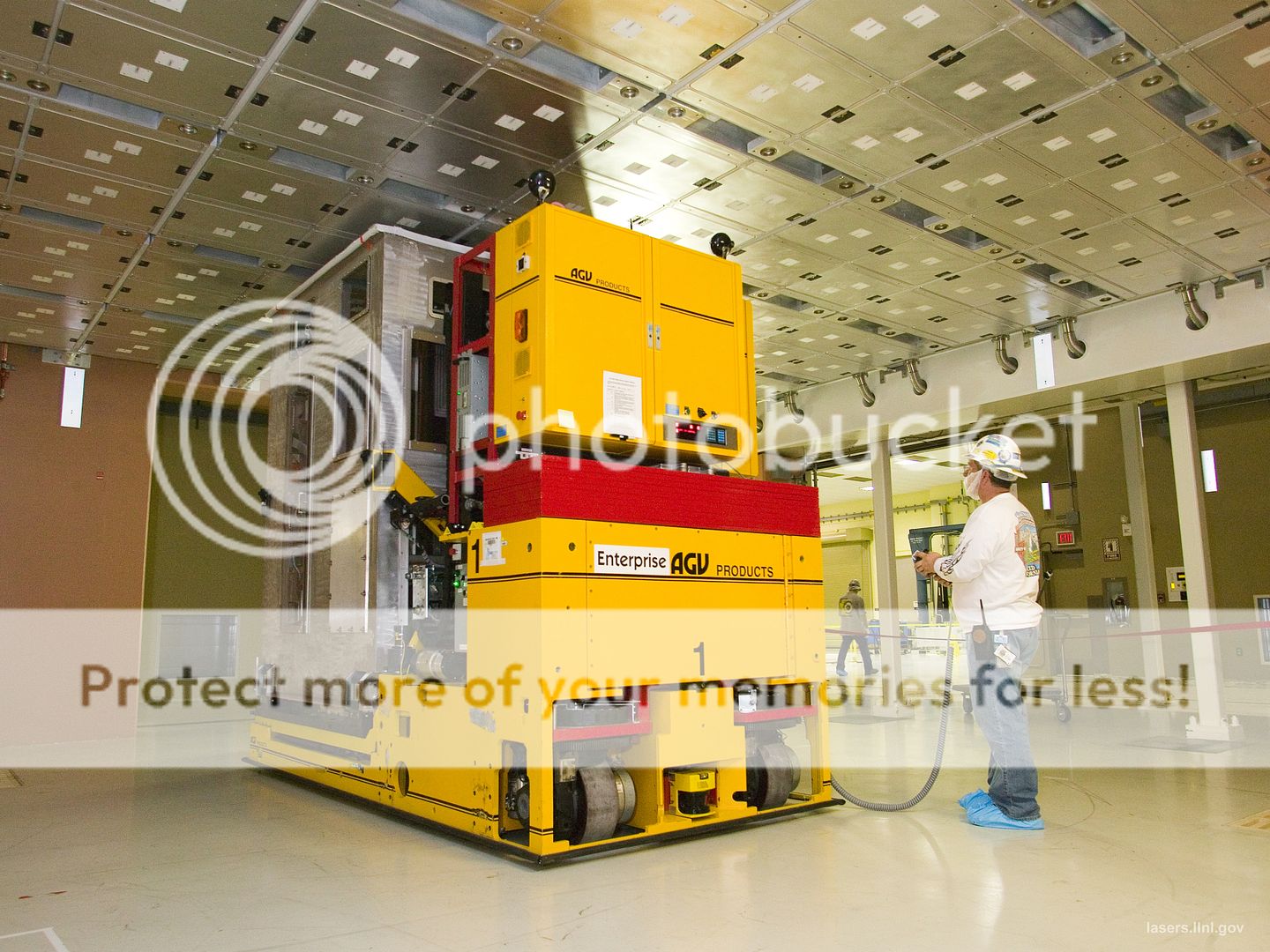
After giving me a minute to ogle, Bruno clears his throat. “The Facility is essentially an energy concentrator in time and space. It takes about sixty seconds to charge up the capacitor bank with six megawatts, but the laser releases that energy in a very short amount of time: billionths of a second. Those six megawatts are concentrated by over fifteen orders of magnitude, more power than the entire United States electrical grid.” The cool thing about lasers is that they have an unlimited threshold for delivering power. Photons, the packets that physicists use to quantify light, occupy no space, so you can pack an unlimited number of them into as focused a path as your lenses allow.
The charge process concentrate the lasers through time, and the lenses concentrate them through space. Each of the tubes acts like a telescope, converging NIF’s 192 beams onto a single capsule the size of a vitamin, gaining another nine orders of magnitude in the process to create temperatures hotter than the inside of the sun.

At the molecular level, heat causes vibration. The hydrogen ions in the fuel capsule are both positively charged, so they magnetically repel one another. However, the supercharged laser creates a perfectly symmetrical layer of plasma around the target. There’s nowhere for the ions to run, and as they heat up and accelerate to over a million miles per hour, the two cores inevitably fuse to become a hydrogen atom, releasing some of their mass as energy in the form of neutrons. Each laser bay contains 96 beams, one in each steel tube. Thick black high-voltage cables snake along the outside delivering power to the amplifiers. The tubes are filled with Argon gas because air reacts with lasers and impedes their progress. Aside from the amplifiers, the lasers also pass through pink slabs of neodymium that add juice to the discharge. The shot bounces through the entire array four times before it enters the switchyard into the target bay.
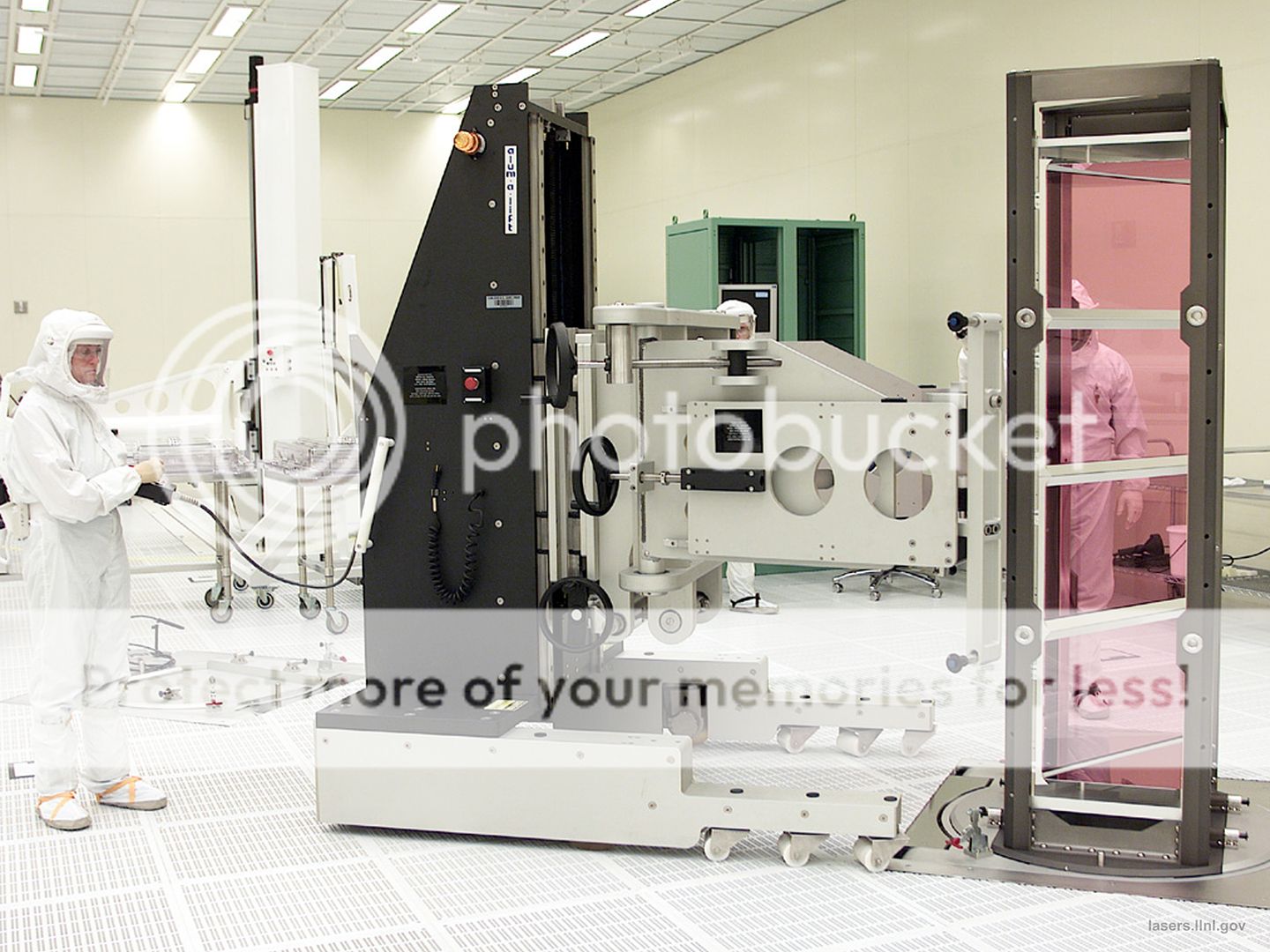
This is the world’s largest optical system. There are over 70,000 large optical controllers and 30,000 smaller optics. As we look over it all from the third floor, Bruno sniffs, “If you could look through all these tubes and strip away all this steel, you would find a sea of optical elements. It would be beautiful. Right now, it just looks like tubes.”
Between the Conception and the Creation

Every shot starts in the Oscillator Room, which is a somewhat disappointing set of server-like cabinets containing the three oscillators that send out the initial pulse to the preamplifiers. This starting pulse is only a billionth of a joule, or 1/160th the kinetic energy of a flying mosquito. A fairly humble beginning for a star’s birth. They use the three oscillators in tandem to fine-tune the timing of the pulse down to a few trillionths of a second. The oscillators run constantly, but only one of these pulses will enter the amplifiers to begin powering up for a shot. A large red counter keeps track of all pulses that pass without notice through the fiber-optics, unable to reach their full potential in the adjacent laser bays.

In 1957, John Nuckolls began investigating peaceful applications of nuclear weapons technology. He proposed a novel scheme: the implosion of a Deuterium-Tritium (hydrogen isotopes) fuel capsule inside a tiny holhraum driven by an external energy source (refer to above graphic). This is the same scheme NIF uses today, but at the time when Nuckolls proposed it the laser had not yet been invented, so he considered other exotic power sources like particle accelerators, plasma guns, and hypervelocity pellet guns, which sound suspiciously like glorified BB guns.
The reaction that takes place at NIF today is almost identical to the one Nuckolls designed in the 60s, but the physicists needed a laser system capable of generating a pulse hotter than the core of our sun to achieve ignition. First they built the SHIVA laser, named for Oppenheimer’s proclamation that he had become the destroyer of worlds after unveiling the atomic bomb. SHIVA was followed by NOVA, NIF’s predecessor and the first laser system Bruno worked on at the facility. In late 2009, almost fifty years after the idea was conceived, NIF successfully demonstrated the temperatures necessary for energy gain ignition. “It was so much bigger than any of us ever imagined,” Bruno reflected. “When we bring in the original scientists to look at the target bay, they sort of look around in awe and say, ‘We can’t believe this is what we asked for.’”

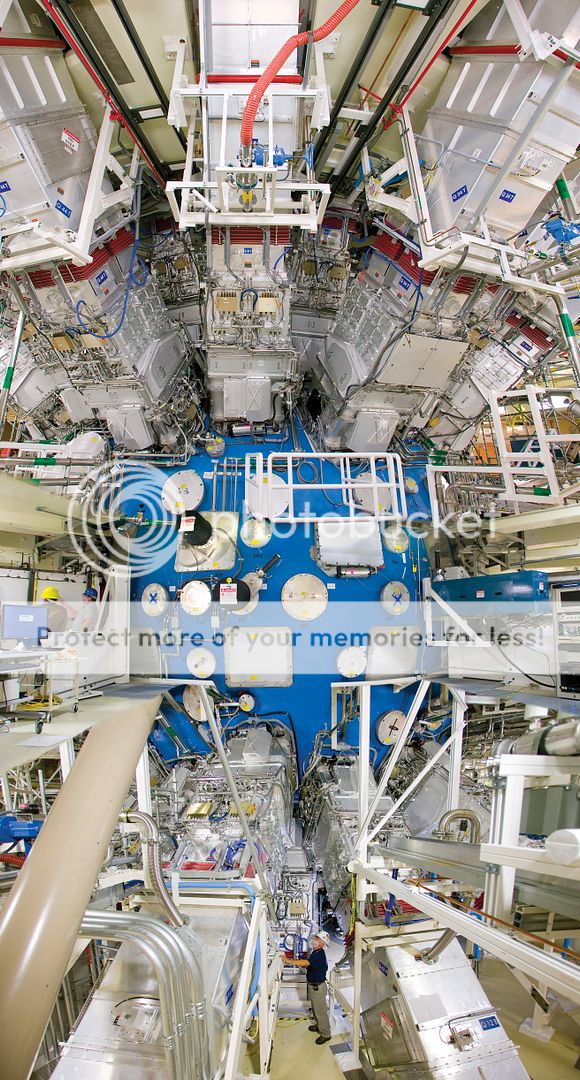
The target chamber is a 10-meter diameter aluminum sphere with laser tubes sprouting from its surface. From the outside, it looks like one of those alien objects from Contact or Sphere. It spans three stories of the facility, so you can only ever look at it from above or below. We stand on the third floor watching a crew of workers install some newly hardened diagnostic equipment. They’ve spent the past six months preparing the target chamber to absorb the massive amount of energy released by the fusion reaction. The entire chamber is now surrounded by a concrete and boron barrier two meters thick. In the LIFE facility, a commercial power plant designed to actually generate electricity, the neutrons will be absorbed by a mantle of liquid salts that transfer their kinetic energy to heat energy which drives a conventional steam generator. However, because NIF is an experimental facility where they actually need to observe the reaction, its physicists were presented with the challenge of preparing cameras that could withstand the bombardment, since neutrons lay waste to electronics.
The density of the imploding target is so high that normal x-rays can’t penetrate the implosion’s surface, so they concentrate four x-ray beams to over a Petawatt, which is a quadrillion watts (yeah, real number). The reaction itself is only a tenth of the size of a human hair, and it boggles even the scientists who work there that they have an x-ray powerful enough to observe it. They call this camera Dante, “because it looks into the mouth of hell.” Despite the incredibly powerful forces at work, Inertial Confined Fusion is safer than any of the power-generating technologies that have preceded it. The key thing to remember is that the reaction is an implosion, not an explosion. If anything goes wrong, the whole thing collapses on itself and nothing happens. The worst thing that can happen is all the fuel gets consumed and we’re out one more capsule. There’s no possibility of a catastrophic meltdown like Three Mile Island or Chernobyl. Lynda deals with this line of questioning all the time: “People hear that NIF generates temperatures hotter than the sun and that it creates a miniature star and they wonder how the whole facility doesn’t melt down. But we’re talking about an implosion, with an incredibly small scale, for only a few billionths of a second. It’s no different than a supernova, the physics are all the same, but the scale’s a bit smaller.”

Holhraum is the German word for “hollow room.” It has been mostly analogized to a pill capsule, in reference to its size and shape. Its role is to act as an x-ray oven, containing the plasma generated around the target pellet and acting as a mold for the fusion reaction’s symmetry. The holhraum contains the fuel pellet made up of the hydrogen isotopes Tritium and Deuterium. There’s no danger of scarcity with these two elements: Tritium is derived from the relatively common Lithium and Deuterium comes from plain old water. Another advantage to fusion is that there’s no waste created, at all. Everything is consumed by the reaction, leaving behind no toxic radiation or weaponizable elements. In fact, physicists can use facilities like NIF to dispose of the nuclear waste from the previous generation of fission reactors, rendering the arguments about Yucca mountain or blasting it into space completely moot.

The shot director begins the countdown, and alarms sound throughout the facility. Daylight hours at the facility mostly consist of construction and maintenance work, they fire the lasers at night. There are only twenty people in the facility during a shot, and they’re all here in the control room, but they have the alarms just in case. The countdown is four minutes, which seems like an incredibly long time. Nearly all of the process is controlled by computers, a necessity for the minute level of control required to achieve symmetry. The control room looks a lot like NASA’s Mission Control. They like to hire nuclear submarine captains as shot directors, because of the rigidity in operations requirements. “We can train them with the technical knowledge, but having that operations experience from a submarine where things are going on all around you is essential. There’s a lot of action during a shot, but each one can take up to twelve hours. It’s like loading a new missile every day.”
As we reach the final few seconds of the countdown, I look around nervously. The overhead lights flash, and that’s it. No sound effects, no shaking. I have to ask if it worked. The only noise comes from the physicists next door scrambling to be the first to retrieve the data. Lynda leans over, “When you take the amount of shots fired in an entire year, where each one only takes a fraction of a second, it’s almost like this thing is never really on.”
Countdown to Ignition
The National Ignition Campaign coincides with football season, but the stakes are a little higher. Ignition is the validation of fusion as a viable energy source, the point at which the critics are silenced and the rest of the world scrambles to duplicate the feat. “It’s going to be incredible, standing room only. There’s people lining up around the world that want to be here for that event. Every milestone along the way has been a major event, when we went from two to four lasers it was a major event. Now we have 192. And it’s all leading up to the ignition.” The question they must get tired of hearing is: when? “September, October. There’s a few [target] options we have, a plastic capsule, a beryllium capsule, a diamond capsule.” I ask Bruno which one he thinks will do the trick. It’s important not to underestimate the technological perfection required to achieve the symmetry necessary for the ignition. Every aspect of the shot must be analyzed and optimized to an order of precision never before achieved. With all that said, he doesn’t see any reason why the plastic capsule won’t get the job done.
I have to press: “The plastic capsule, that’s going to be the one?” Bruno replies with a tremor in his voice. Like the girl who’s fallen for too many bad boys, he’s been hurt before, “I believe that will be the one, yes.”
Are you ready for some Physics?
The above title sounds a lot more enticing if you sing it to the Monday Night Football theme song. There’s no good reason why I should be allowed into a nuclear weapons lab. I’m nobody, another starving bookworm with a taste for Faulkner and single barrel scotch. All I can surmise is that so far, no-one’s managed to pull this four billion dollar sword from its stone and shove it somewhere that will make the American public pay attention. I’m living proof that they’re desperate. No one I know has even heard of the National Ignition Facility, which quite sadly included the Editor of ScriptPhD.com who sent me there. I’ve spoken with professional engineers and physicists who don’t recognize the name. There’s certainly been plenty of media coverage: the BBC, the Discovery Channel, Wired, Time. People’s ears tend to perk up when they hear something might kill them, but the general public hasn’t had a survival-based reason to pay attention to physics since the end of the Cold War. We know that unruly nations getting access to nuclear weapons is a bad thing, but as to the current state of the field, a nuclear warhead is implicitly bad enough that there’s been no reason to continue following their progress.
Fusion offers us the solution to a problem most people don’t even know we have. The immediacy of it isn’t so clear, but in his excellent BBC Horizons: Can We Make a Star?, Professor Brian Cox paints a grim picture. It’s not possible to give the rest of the world access to even half the electricity that the average American uses without bankrupting all possible means of generating electricity, and in the process laying waste to the environment.
We have to figure out how to generate electricity for the growing population around the world without, as Bruno likes to say, choking ourselves. The actual numbers are sobering, but it’s a subject people don’t like to read about because in the past there’s been no clear solution. Now here we are, being handed that solution on a silver platter by a group of individuals that no one’s heard of who have been working on that solution for the last fifty years. Which only makes the endeavor that much more noble.
The Holy Grail
When I began this trip, I had no idea that I would be making a pilgrimage. Bruno and his co-workers are like stonemasons laying the foundation for a church they will never live to see. It will be at least twenty years before the first commercial fusion reactors come online (skeptics put the time-frame around 2050). John Nuckolls, the man who came up with Inertial Confinement Fusion, is in his nineties. Five thousand people have spent their lives building this facility up to this point. They are the clergy of the modern era, humanity’s most educated class, working selflessly to create a better world. “People want to be here to work on a mission. The goal is really very abstract to many of them, but they’re all motivated by being able to contribute to an event where they can make history. There’s a grand challenge to it, a vast significance in being a part of that.”
Gone are the days when the average American held down a job for the same company his or her entire working life, but many at the National Ignition Facility join the team when they finish their doctorates from the world’s finest universities and work there until they retire. There are fathers who have spent their entire careers working on fusion only to see their son or daughter take up the cause. Remarked Bruno: “We have to think long term. You need technology that can carry you beyond fifty and a hundred years into the future. When you think about your great grandchildren, this is the only solution, the only way that we can survive with the quality of life that we’ve become accustomed to. It is our holy grail.”
The Neutron Age
The achievement of energy gain fusion is one that should fundamentally alter human existence. As technology advances, our quality of life will remain intimately connected with access to cheap, renewable energy. There are existential stakes as well. Fusion is the engine that drives our universe. By achieving Ignition, we begin our mastery of Mother Nature’s own energy source, a force so fundamental that cultures around the world worshiped its daily appearance at dawn. “Every fifty to a hundred years you reach a point where you make a quantum jump in technology. We went from coal in the industrial age to the atomic age in the fifties and now we will reach the neutron age. We can finally see an opening into the energy problem. Within fifty years you could provide a significant fraction of your basic power production from fusion. You can give this to developing countries and bring them into a new century. Suddenly someone with no refrigerator, no microwave will realize what it means to live in the modern age. We have a quality of life here in America that simply cannot be provided around the world with the resources we have. Fusion will make that possible.”
Clean power is only the beginning. Like the technologies that emerged from the Pandora’s box of quantum mechanics, fusion will undoubtedly open up a whole new wave of technological advancement. Every aspect of the National Ignition Facility, from the optics that carry the lasers to the supercomputers that process the data have pushed the limits in their field. Bruno gives me a sly look. “We probably have no idea yet what applications will come from having a neutron source like this.” And thanks to the NIF’s tireless believers, we enter that neutron age this fall.
Stephen Compson studied English and Physics at Pomona College. He writes fiction and screenplays and is currently working toward a Master of Fine Arts at UCLA’s School of Theater, Film & Television.
~*Stephen Compson*~
************************
ScriptPhD.com covers science and technology in entertainment, media and advertising. Hire our consulting company for creative content development.
Subscribe to free email notifications of new posts on our home page.
]]>
Nothing has done more to reinvigorate discussions about energy and fuel dependence than the tragic oil spill currently afflicting the Gulf Coast [excellent resource for trajectory, timeline and news sources]. Though scientists and oil manufacturers continue to debate the validity of the “Peak Oil” theory, a very uncomfortable reality looms that oil production may not be able to keep up with thirsty demand. With an ever-increasing global population, a constant proliferation of technology choices and lifestyle improvements, and a rising middle class in third world countries, the factors contributing to fuel consumption may be the precipice of an eventual geopolitical crisis. In an effort to showcase their dedication to addressing the most salient energy and environmental questions affecting our generation, the Discovery Channel, backed by founder John Hendricks, is launching a revolutionary four-part documentary called Powering The Future. In it, they address a range of economics, national security, social and scientific questions related to energy and fuel all through the single focal point of searching for a modern, clean, limitless supply of energy. Our coverage of Powering the Future includes a review of the first installment and an exclusive podcast interview with the show’s host, lead scientist for the Nature Conservancy, Dr. M. Sanjayan. For full content, please click “continue reading.”

“We are the energy generation, but we as Americans do not fundamentally understand what energy is, where it comes from, how we use it, and how much we need,” remarks Dr. M. Sanjayan, host of the new Discovery Channel four-part documentary Powering The Future. Indeed, any honest retrospective of the modern energy crisis first requires a primer reviewing how our dependence on major fuel sources (coal, oil, and natural gas) came about and the unique challenges that breaking it poses. I consider myself a fairly well-informed individual, particularly on scientific matters, but in watching the first installment, The Energy Revolution, even I was amazed at the sheer interconnectedness of major electrical grids, and how much links us globally in energy delivery vessels. A German electrical engineer in the documentary compares running a major grid to being an air traffic controller.
Much of the current hope for alternative energy sources rests in grandiose ‘silver bullet’ solutions. Scientists at the National Ignition Facility are using the world’s biggest and highest powered lasers as a power source for smashing together the hydrogen atoms in a droplet of water, resulting in nuclear fusion. This mimics the way that the sun makes energy, and, if successful, would harness a limitless supply of power. Nuclear fusion research has been ongoing since the 1940s, but has never been applied successfully on a large enough scale like the undergoing experiments at the Ignition Facility. [ScriptPhD.com was recently granted an exclusive tour of the Ignition Facility, which will be covered soon in a separate post.] Another growing ‘silver bullet’ sector has been the harnessing of two natural energy sources—the sun and wind. Wind energy is the largest (and fastest-growing) alternative source of energy. Denmark gets about 20% of its power from wind sources, while the United States gets approximately 1.2%. Photovoltaic, or solar panels, more mobile and aesthetically pleasing than wind turbines, are another popular source of alternative energy. Little money has been poured into researching photovoltaic grids as a large-scale source of energy, it holds promise. The 89 petawatts of sun that shines on the Earth each year is more than 6,000 times the 15 terawatts of electrical power consumed by human. Unfortunately, both of these energy sources face one insurmountable hurdle; their mercurial natures. Our modern lifestyles require a constant influx of power, but if the sun stops shining, or the wind stops blowing, solar and wind technologies are unreliable.
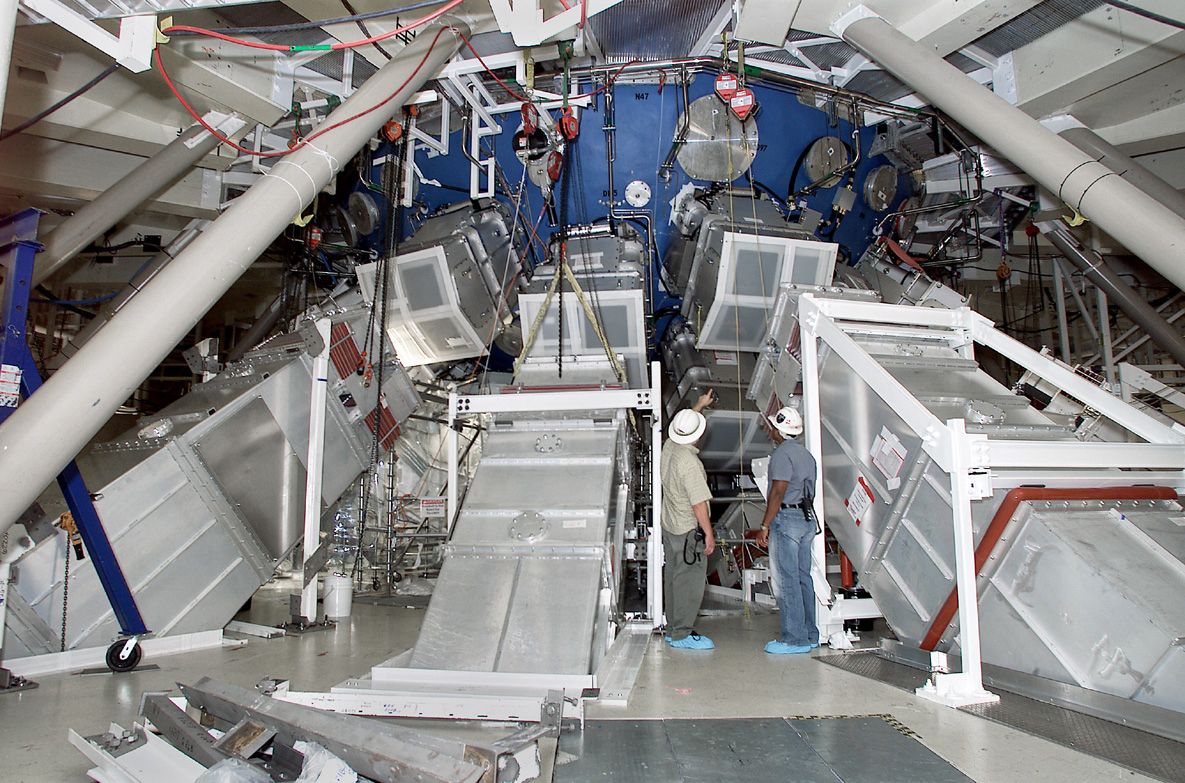
The reality is that moving energy consumption into the 21st Century will not happen with one grand discovery, but a microcosm of intermediary ones. Powering The Future provides some exciting insight into the body of research and creativity being applied to alternative energy sources. Many communities are powering themselves through clever solutions, such as Japan generating solar energy in outer space and then beaming it to Earth, or New York City harnessing wind energy from tidal waves in the East River. No role is rendered more important in this documentary than that of private organizations and academia in leading innovation and discovery. Bay Area-based Makani Power specializes in capturing and storing high-altitude wind for abundant power and energy. Caltech University solar electrochemist Dr. Nate Lewis has invented a thin coating of paint containing chemicals that catalyze the sun’s energy for power. Paint your roof, get free solar energy! In fact, just today, General Electric announced a $200 million smart grid contest for cleaner and more efficient electrical grids. The California-based X-Prize Foundation has even gotten in on the act, recently announcing a $10 million oil spill cleanup challenge.
Even those that consider themselves knowledgeable about environmental issues and research and technology of clean energy will have a lot to learn from Powering The Future. The special does an exceptional job of laying out the complex science behind concepts such as fusion and large-scale electrical grids for a lay audience to understand, while not glossing over current research in industry and academia. Moreover, rather than approaching the issue with the typical heavy-laden, moribund fatalism one often finds in these specials, Powering The Future leaves one feeling hopeful about the range of innovation happening at all levels worldwide, and the remarkable commitment of both academic labs and private companies for tireless discovery. It is this very entrepreneurial, resilient, and utterly human, attitude that will power our future more than any fossil fuel ever could.
Powering The Future premieres on the Discovery Channel on Saturday, July 17, 2010 at 8 PM ET/PT.
Finally, we encourage you to listen to our exclusive one-on-one podcast interview with Dr. M. Sanjayan (18:00), lead scientist of the Nature Conservancy, as we expand the energy discussion of the mini-series to global solutions, his thoughts on the oil spill crisis, and ways that we can impact our dependence on fuels right now.
~*ScriptPhD*~
*****************
ScriptPhD.com covers science and technology in entertainment, media and advertising. Hire our consulting company for creative content development.
Subscribe to free email notifications of new posts on our home page.
]]>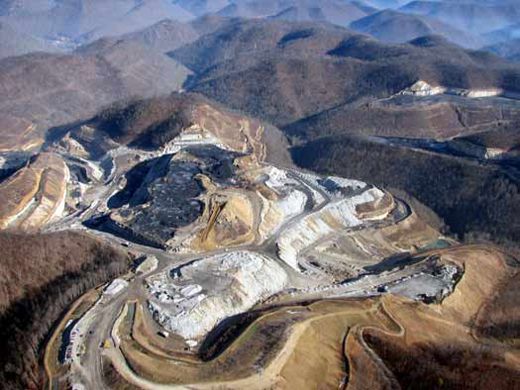
One of the most pressing issues of our time is how and where we are going to get sustainable energy for a global population with a rapidly rising standard of living and the consumption that this entails. Approximately 10% of United States coal production [coal in general accounts for 40% of global electricity production] is procured through mountaintop removal, an environmentally-devastating extraction that literally involves blasting off (or removing) the top of a mountain to extract the coal inside. The practice gained popularity in the 1960s, when it started becoming too difficult and too costly to extract coal from underground mines. In our continuing “It’s Not Easy Being Green” series, ScriptPhD.com’s eco-blogger Captain Planet talks about the documentary Mountaintop Removal, exactly what it entails, and why this process is so much more costly than the immediate energy gained from it. Please click “continue reading” for more.
“Take away wilderness and you take away the opportunity to be American.” –Roderick Nash, from ‘Wilderness and the American Mind’
If you were wondering where the sets for the land of Mordor were filmed for the Lord of the Rings trilogy, the answer would be New Zealand. But after viewing Mountaintop Removal, a well done, if homely, documentary currently in rotation on PBS and a film festival darling, the answer could just as easily have been a coal mining site in West Virginia.
So begins the story of Mountaintop Removal, with shaky aerial shots of mountains which, as you may have guessed by the name of the film, have had their tops removed. The resulting carnage of mountaintop removal is horrific in its environmental damage, toxic impact on human health, and permanent mutilation of a once-beautiful geography. As the film is quick to point out, you can cut down a forest, and eventually, it could grow back. But when you slice off the top of a mountain and extract all the coal inside, the mountain doesn’t grow back. Ever. What was once idyllic countryside in the Appalachian Mountains is quickly becoming a nightmare of epic proportions. To date, mountaintop removal has destroyed 1,000,000 acres in the Appalachian area.
The dirty secret behind goal is that it comprises 50% of the USA’s energy production. Burning coal is the cheapest way we know of to produce electricity, but it is also the most harmful in terms of the amount of carbon dioxide it produces, hastening the rise of the planet’s thermostat. Jeff Goodell, a coal specialist and author of Big Coal, says in the film that when he first started researching coal, he was surprised that we actually still use it today. He thought it had gone the way of the horse buggy and top hat. “I thought that electricity was just something that flowed down from a golden bowl in the sky. I never gave any thought to where it came from.”
So where does it come from, and how does mountaintop removal work, anyway? The organization Aurora Lights.org has an exceptional collection of information about mining, coal removal and alternative energy, and is a great resource for in-depth information. In essence, the practice of mountaintop removal is a five-part process. It begins with clearing, literally razing, burning and deforesting the trees to provide an unobstructed mining path:

The process continues with blasting, usually involving the use of dynamite to clear away earth and rock above the coal seams. This process in particular releases silica and chemical-ladden dust as airborne
particles to surrounding communities:

Next is the critical step of digging to clear rubble leftover from the blast and expose the coal seams directly for extraction and removal:

The rubble from the denuded mountains is dumped in the next step, called a valley fill, in which tons of rubble are relocated into the mountain’s valleys. This process has buried 1,900 miles of headwater streams (more on this below) and increased flooding during rainfall.
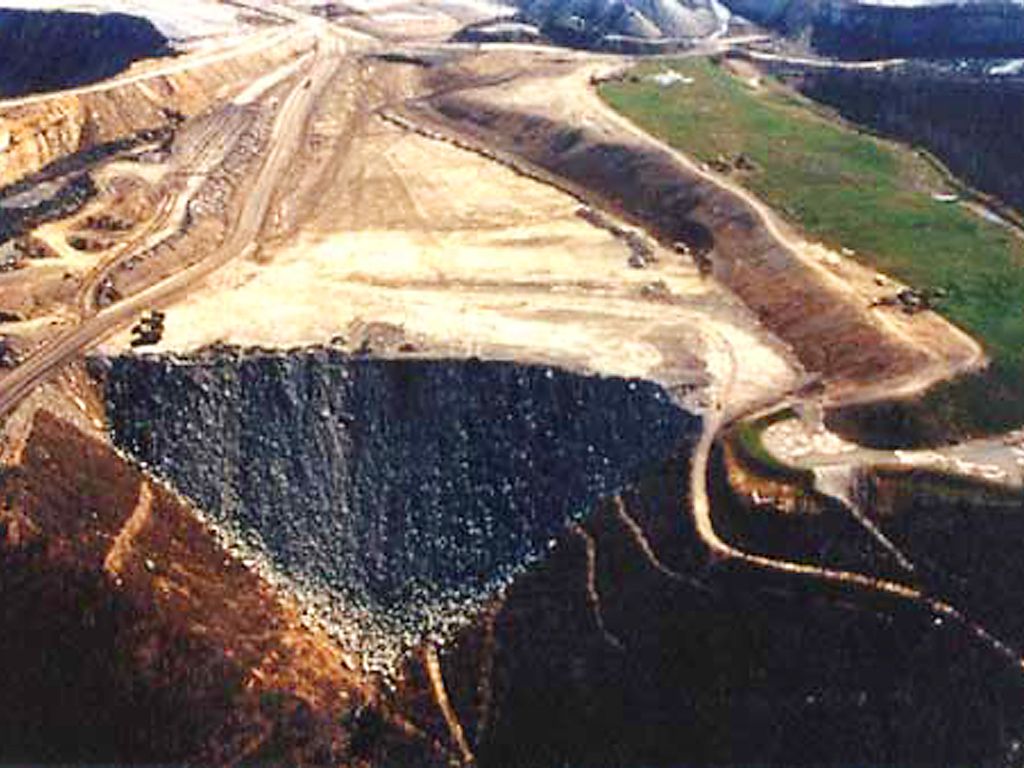
Finally, after all the coal has been mined, the barren mountainside is “replenished” reclamation, a largely superficial aesthetic process that involves planting of grass and plants, most of which will not ultimately be able to survive in the rocky ground.

If any or all of this sounds environmentally devastating, that’s because it is.
The Mountaintop Removal documentary highlights a coalition of concerned citizens who have organized to prevent further coal mining. They are comprised of college students, parents and environmentalists. The film introduces us a small elementary school in West Virginia with a coal mine in its backyard. The school sits next door to a “lake” full of coal slurry (akin to toxic sludge), which includes large volumes of lead, arsenic and cadmium. The children of the school have suffered increased rates of asthma, headaches and mouth sores, to name a few of the most common maladies. In a particularly effective scene, the parents of these school children march into the governor’s mansion unannounced and ask the Governor to relocate their children’s school to an area away from the coal mines.
The underlying issue of coal production is at the heart of our nation’s energy policy. As one interviewee so succinctly puts it in the film, we are at a crossroads where we must decide if we’re going to convert to sustainable,
green sources or continue pursuing non-renewable sources that pollute the environment and contribute to global warming. If you’ve been watching any television episodes on Hulu lately, you may have come across an advertisement for Coal River Wind. It’s a movement underway to install a fleet of wind turbines on the side of Coal River Mountain in West Virginia. It’s a race against time because Massey Energy (contact them today!), the lead coal company featured in Mountaintop Removal, has filed permits to remove the mountaintop which would destroy the wind potential. The Coal River Wind website urges visitors to write to the EPA, sign their petition and donate. It’s a microcosm of the country’s political will and long-term energy policy.
The most effective point that Mountaintop Removal ultimately makes is one of sustainability. Once the mountain ranges of Appalachia have been stripped of all coal, the coal companies will move on to other areas or dissolve. What they will leave in their wake will be broken economies, blighted landscapes and a host of health problems for anyone who is still living in the area, effectively turning the Appalachians into something like a modern-day dust bowl.
The scientific consensus on mountaintop coal mining is stunningly clear. Last month, an analysis of collected scientific studies concluded in the scholarly journal Science that mountaintop coal mining is deleterious to both the environment and human health and should be banned altogether. In all, this coal extraction process has filled 700 miles of US streams with debris, sludge and toxic pollution. Sadly, President Obama’s recent compromise with the Patriot Coal Company will steamroll [pardon the pun] a major mining project in West Virginia.
Mountaintop Removal trailer:
Websites that you can visit and organizations to get involved in to help stop mountaintop removal mining:
Coal River Mountain Watch
Ohio Valley Environmental Coalition
WV Highlands Conservancy
Mountain Justice Summer
Earthjustice
Photographer George Wuerthner has magnificently documented the ravages of mountaintop mining removal in Kentucky. The jarring mages are enough to implore you to get involved today.
CaptainPlanet is an LA-based, Northwestern University-educated eco-charged sustainability guru who loves film, psychology and saving the planet, one waterless urinal at a time…
~*CaptainPlanet*~
*******************
ScriptPhD.com covers science and technology in entertainment, media and advertising. Hire our consulting company for creative content development.
Follow us on Twitter and our Facebook fan page. Subscribe to free email notifications of new posts on our home page.
]]>
